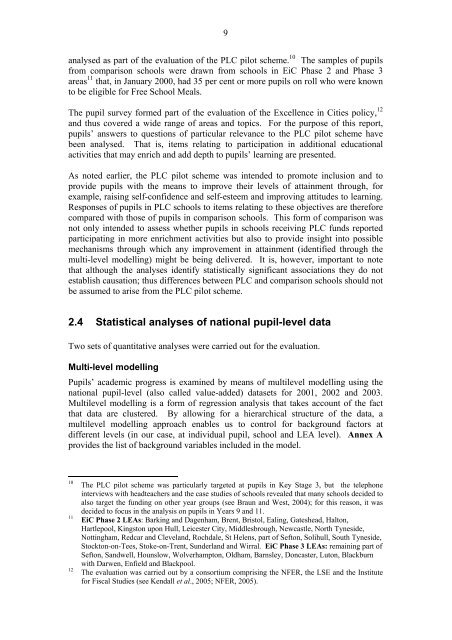Final Report of the Evaluation of the Pupil Learning Credits Pilot ...
Final Report of the Evaluation of the Pupil Learning Credits Pilot ...
Final Report of the Evaluation of the Pupil Learning Credits Pilot ...
You also want an ePaper? Increase the reach of your titles
YUMPU automatically turns print PDFs into web optimized ePapers that Google loves.
9<br />
analysed as part <strong>of</strong> <strong>the</strong> evaluation <strong>of</strong> <strong>the</strong> PLC pilot scheme. 10 The samples <strong>of</strong> pupils<br />
from comparison schools were drawn from schools in EiC Phase 2 and Phase 3<br />
areas 11 that, in January 2000, had 35 per cent or more pupils on roll who were known<br />
to be eligible for Free School Meals.<br />
The pupil survey formed part <strong>of</strong> <strong>the</strong> evaluation <strong>of</strong> <strong>the</strong> Excellence in Cities policy, 12<br />
and thus covered a wide range <strong>of</strong> areas and topics. For <strong>the</strong> purpose <strong>of</strong> this report,<br />
pupils’ answers to questions <strong>of</strong> particular relevance to <strong>the</strong> PLC pilot scheme have<br />
been analysed. That is, items relating to participation in additional educational<br />
activities that may enrich and add depth to pupils’ learning are presented.<br />
As noted earlier, <strong>the</strong> PLC pilot scheme was intended to promote inclusion and to<br />
provide pupils with <strong>the</strong> means to improve <strong>the</strong>ir levels <strong>of</strong> attainment through, for<br />
example, raising self-confidence and self-esteem and improving attitudes to learning.<br />
Responses <strong>of</strong> pupils in PLC schools to items relating to <strong>the</strong>se objectives are <strong>the</strong>refore<br />
compared with those <strong>of</strong> pupils in comparison schools. This form <strong>of</strong> comparison was<br />
not only intended to assess whe<strong>the</strong>r pupils in schools receiving PLC funds reported<br />
participating in more enrichment activities but also to provide insight into possible<br />
mechanisms through which any improvement in attainment (identified through <strong>the</strong><br />
multi-level modelling) might be being delivered. It is, however, important to note<br />
that although <strong>the</strong> analyses identify statistically significant associations <strong>the</strong>y do not<br />
establish causation; thus differences between PLC and comparison schools should not<br />
be assumed to arise from <strong>the</strong> PLC pilot scheme.<br />
2.4 Statistical analyses <strong>of</strong> national pupil-level data<br />
Two sets <strong>of</strong> quantitative analyses were carried out for <strong>the</strong> evaluation.<br />
Multi-level modelling<br />
<strong>Pupil</strong>s’ academic progress is examined by means <strong>of</strong> multilevel modelling using <strong>the</strong><br />
national pupil-level (also called value-added) datasets for 2001, 2002 and 2003.<br />
Multilevel modelling is a form <strong>of</strong> regression analysis that takes account <strong>of</strong> <strong>the</strong> fact<br />
that data are clustered. By allowing for a hierarchical structure <strong>of</strong> <strong>the</strong> data, a<br />
multilevel modelling approach enables us to control for background factors at<br />
different levels (in our case, at individual pupil, school and LEA level). Annex A<br />
provides <strong>the</strong> list <strong>of</strong> background variables included in <strong>the</strong> model.<br />
10<br />
11<br />
12<br />
The PLC pilot scheme was particularly targeted at pupils in Key Stage 3, but <strong>the</strong> telephone<br />
interviews with headteachers and <strong>the</strong> case studies <strong>of</strong> schools revealed that many schools decided to<br />
also target <strong>the</strong> funding on o<strong>the</strong>r year groups (see Braun and West, 2004); for this reason, it was<br />
decided to focus in <strong>the</strong> analysis on pupils in Years 9 and 11.<br />
EiC Phase 2 LEAs: Barking and Dagenham, Brent, Bristol, Ealing, Gateshead, Halton,<br />
Hartlepool, Kingston upon Hull, Leicester City, Middlesbrough, Newcastle, North Tyneside,<br />
Nottingham, Redcar and Cleveland, Rochdale, St Helens, part <strong>of</strong> Sefton, Solihull, South Tyneside,<br />
Stockton-on-Tees, Stoke-on-Trent, Sunderland and Wirral. EiC Phase 3 LEAs: remaining part <strong>of</strong><br />
Sefton, Sandwell, Hounslow, Wolverhampton, Oldham, Barnsley, Doncaster, Luton, Blackburn<br />
with Darwen, Enfield and Blackpool.<br />
The evaluation was carried out by a consortium comprising <strong>the</strong> NFER, <strong>the</strong> LSE and <strong>the</strong> Institute<br />
for Fiscal Studies (see Kendall et al., 2005; NFER, 2005).

















